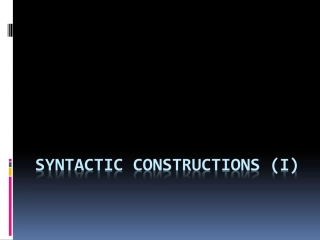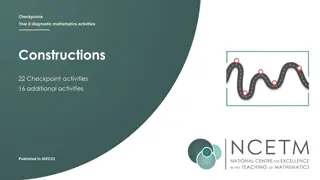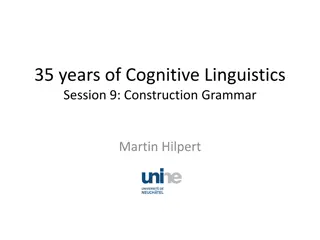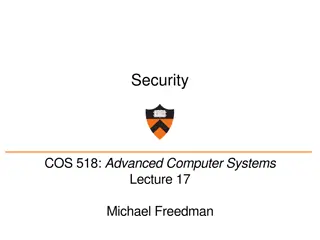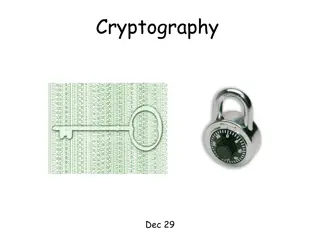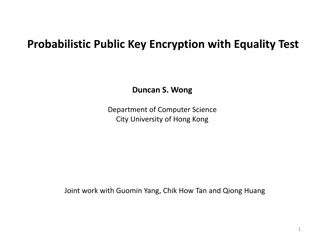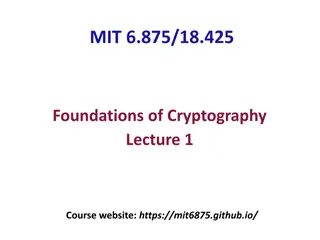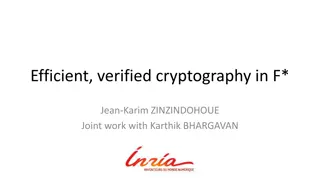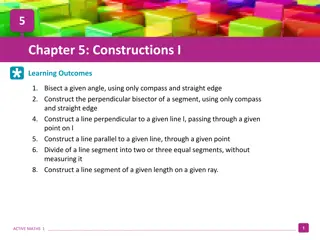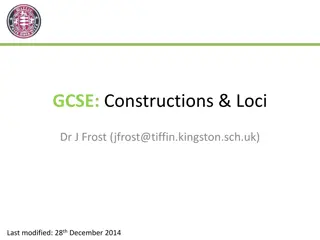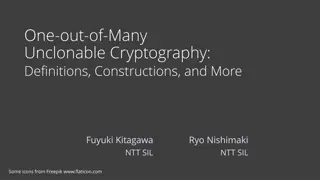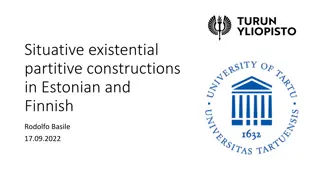Advanced Cryptography Techniques: PKE/KEM Constructions
Explore cutting-edge advancements in cryptography such as PKE/KEM constructions based on lattice-based schemes like Frodo, Kyber, and Saber, as well as isogenies like SIKE. Learn about key generation processes, public key components, encryption methods, and recovery techniques. Delve into the nuances of noise distribution, product structure vulnerabilities, and design choices for enhanced security against characteristic attacks. Discover how fixed weight and rounding play crucial roles in mitigating failure-boosting attacks.
Download Presentation

Please find below an Image/Link to download the presentation.
The content on the website is provided AS IS for your information and personal use only. It may not be sold, licensed, or shared on other websites without obtaining consent from the author.If you encounter any issues during the download, it is possible that the publisher has removed the file from their server.
You are allowed to download the files provided on this website for personal or commercial use, subject to the condition that they are used lawfully. All files are the property of their respective owners.
The content on the website is provided AS IS for your information and personal use only. It may not be sold, licensed, or shared on other websites without obtaining consent from the author.
E N D
Presentation Transcript
PKE/KEM constructions Broadly LWE-like Product LWE Main Variant (Frodo, Kyber, Saber, Three-Bears, LAC, NewHope, Round5, NTRU-LPRime, HQC, RQC) Ouroboros variant (BIKE-3, ROLLO-III) Quotient LWE (NTRU, sNTRUprime, BIKE-1,2 ,LEDAcrypt, ROLLO-1,2) Other Goppa codes (Classic McEliece, NTS-KEM) Isogenies (SIKE)
Product LWE KeyGen: Generate random matrix/module/polynomial: ? and short matrix/module: ?? Public key components: Dec: Calculate ?? ?? ?? ?? ?? ????= ? + ? ?? ?? ? ? ??= ?? ?? Main variant: Recover ? using noise tolerant encoding/ public ECC ??= ? Enc: Ouroboros Variant: Let ? = ? ?? ?? ?? Generate short matrix/module: ?? ?? ?? Instead Recover Using: Encode message noise tolerantly as ? MDPC decoder (BIKE-3) LRPC decoder (ROLLO-III) Ciphertext components: ?? ?? ??+ ? ?? ?? ? ? ? ? ?? ?? =
Quotient LWE KeyGen: Generate short matrix/module: Dec: Calculate ?? ?? ?? ?? ?? ?? ??? = Public key: ??? ? = ?? Recover ?? Using: Enc: Generate short matrix/module: ?? ?? ?? NTRU Trapdoor (NTRU, sNTRUprime) MDPC decoder (BIKE-1,2, LEDAcrypt) LRPC decoder (ROLLO-I, II) Ciphertext: ?? ?? ? = ? ?
Design Choices for Product/Quotient LWE Metric: Euclidean (Frodo, Kyber, Saber, ThreeBears, LAC, NewHope, Round5, NTRU, NTRU-Prime) Characteristic attack: Lattice reduction (LLL, BKZ, Sieving, Enumeration) Hamming (BIKE, HQC, LEDAcrypt) Characteristic attack: Information set decoding Rank (RQC, ROLLO) Characteristic attacks: Combinatorial: Linear algebra search /support trapping Algebraic (Minors, Kipnis-Shamir, Syndrome modeling)
Noise Distribution Fixed Weight (NTRU, sNTRUprime, BIKE, HQC, ROLLO, RQC) Seems to protect against failure boosting attacks. How effectively? For lattices, security proofs generally assume Gaussian noise. Is this distribution different enough to lead to problems? Fixed Weight/Product structure (LEDAcrypt) The product structure enables an attack! Binomial (Frodo, Kyber, LAC, NewHope, ThreeBears) Closer to Gaussian. Close enough? Subject to failure boosting Rounding (NTRU-LPRime, Round5, Saber) No known reduction from LWE to LWR, but no known attacks on normal parameter ranges for LWR KEMs. Subject to failure boosting
Ring/module structure None (Frodo, Round5N1) Larger PKE/CT for product LWE. Much larger public key for quotient (No submissions) Ring (LAC, NewHope, Round5Nd, NTRU, NTRUprime, BIKE, HQC, LEDAcrypt, ROLLO, RQC) Needed to optimize bandwidth for Quotient LWE schemes, as well as Hamming and Rank Schemes Module (Kyber, Saber, ThreeBears) For lattice product LWE, there is essentially no performance penalty for choosing module over ring Is there security benefit to less structured lattice?
Which ring is the one ring to rule them all? Power of 2 cyclotomic ?? / ?2?+ 1 (NewHope, LAC, Kyber, Saber) Enables fast multiplication for NTT (NewHope, Kyber) Lattice search-decision reduction Field (NTRUprime, ROLLO, RQC) ??? Avoids attacks due to factoring polynomial modulus in Rank-based crypto Is this property needed for lattices? Is it meaningful when modulus switching is possible? Prime Quasicyclic ?? / ?? 1 (NTRU, BIKE, HQC, LEDAcrypt) Need to be careful of evaluation at 1 homomorphism If you are, no apparent problems Least factorizable choice for Hamming metric Prime Cyclotomic ?? / (?? 1)/(? 1) (Round5ND) Prime quasicyclic without the factor that allows evaluation at 1 Pseudo-Mersenne 23120 21560 1(ThreeBears) And now, for something completely different
Decoding (Principally relevant for cost of side channel resistance) Regev or NTRU style rounding only (Frodo, Kyber, Saber, NTRU, NTRUPrime) Repetition/Majority (NewHope) XE5 (Round5) Melas FEC (ThreeBears) BCH (LAC, HQC) Gabidulin (RQC) LRPC decoder (ROLLO) BitFlipping (BIKE, LEDAcrypt)


